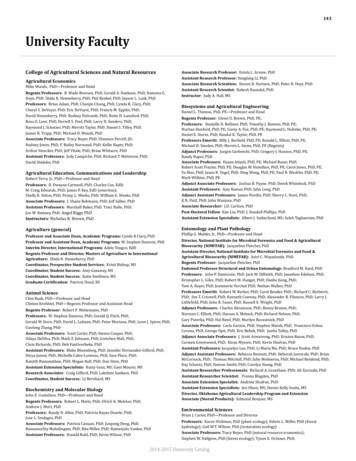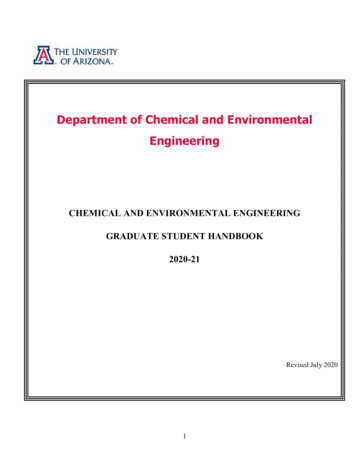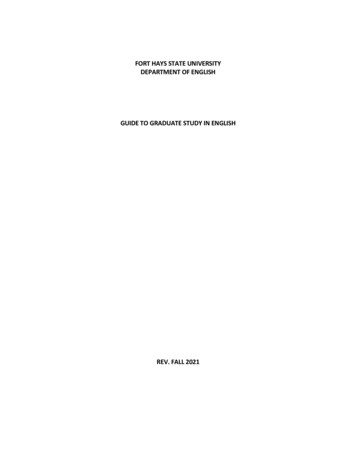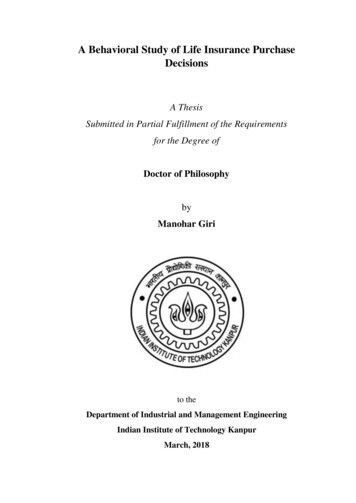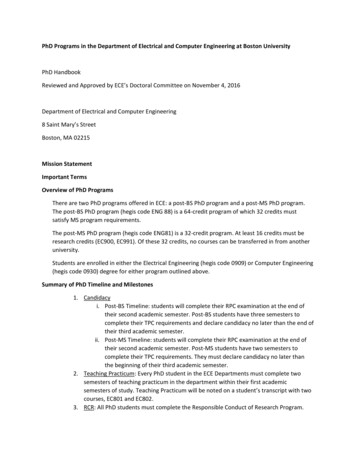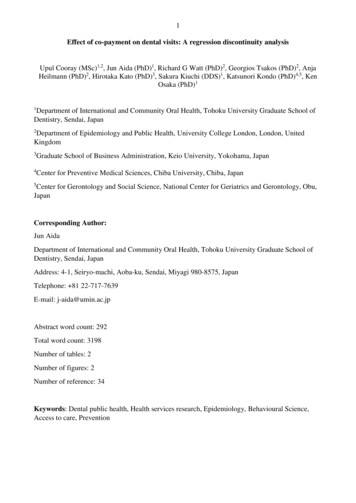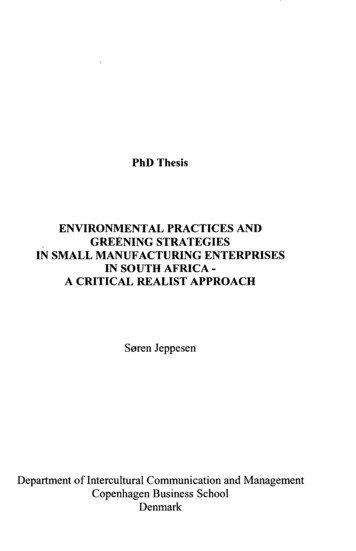
Transcription
PhD ThesisENVIRONMENTAL PRACTICES ANDGREENING STRATEGIESIN SMALL MANUFACTURING ENTERPRISESIN SOUTH AFRICA A CRITICAL REALIST APPROACHSoren JeppesenDepartment of Intercultural Communication and ManagementCopenhagen Business SchoolDenmark
Table of ContentsACKNOWLEDGEMENTSIILIST OF TABLES AND FIGURESABBREVIATIONSIXXPART I - THE SCIENTIFIC FRAMEWORK1CHAPTER 1. GREENING OF SMES - A NEW PERSPECTIVE?2/./. Motivation21.2. Research focus and aim41.3. Research questions and purpose61.4. Methodology. Research strategy, research designs and data collection methods71.4.1. Research strategy71.4.2. Research design91.4.3. Data collection methods and the research process101.5. Theory and analytical framework111.6. Epistemological considerations and delimitations121.7. Style & structure13CHAPTER 2. ENVIRONMENTAL MANAGEMENT IN INDUSTRY AND THE GREENINGOF SME LITERATURE152.1. Environmental Management in Industry (EMI) and Greening ofSMEs: An introduction ofthe international literature162.1.1. Paradigm shift theories172.1.2. Win-win theories182.1.3. Stakeholder management theories242.1.4. Toolbox approaches262.1.5. Greening of business functional theories272.1.6. Investigations of greening issues in the Third World282.2. The Greening of SME literature and its relevance to the thesis322.2.1. A characteristic of the EMI literature322.2.2. A characteristic of the greening of SMEs literature342.2.3. Towards a new perspective and an alternative approach to investigating the greeningof SMEs37CHAPTER 3. A CRITICAL REALIST APPROACH TO GREENING OF SMES413.1. The Critical Realist Perspective413.1.1. Critical Realism and the essential elements423.1.2. Explanation in the CRP463.1.3. The CRP and its main schools483.2. CRP within social sciences503.3. A Critical Realist Approach to studies in social science523.3.1. Types of research in a CRA. Research strategy533.3.2. Research design in a CRA563.4. A CRA for studying environmental practices and greening strategies in SMEs59CHAPTER 4. A THEORETICAL-ANALYTICAL FRAMEWORK FOR INVESTIGATINGDRIVING FORCES OF GREENING IN SMES634.1. Neo-classical theory of the firm and Industrial economics644.1.1. Theories of the firm in neo-classical economics644.1.2. Dynamic Industrial Economics perspectives on thefirm65IV
4.2. Resource Based Perspectives (RBP)694.2.1. Dynamic capabilities and core competencies704.3. RBP-contributions on Greening, SMEs and a Third World context724.3.1. RBP and greening contributions724.3.2. RBP and SMEs734.3.3. Contextual theories of firms in the Third World744.4. The theoretical-analyticalframework of the thesis774.4.1. My theoretical-analytical framework78CHAPTER 5. THE THREE RESEARCH DESIGNS FOR EMPIRICAL INVESTIGATIONS. 835.1. The intensive research design855.1.1. The use of qualitative methods for intensive research865.1.2. Choice of methods for data collection and the setting up of the intensive study915.2. The explorative research design925.3. The extensive research design945.4. Outline of the next parts of the thesis96PART II - THE CONTEXTUALISATION97CHAPTER 6. INDUSTRY AND ENVIRONMENT IN SOUTH AFRICA986.1. The unique features of South Africa - a macro perspective996.2. The legacies of apartheid1036.3. Governmental initiatives in the transition process1076.4. Thesrecent industrial development in South Africa1106.4.1. The new industrial policies in South Africa1106.4.2. Promotion of the SME-sector- institutions, policies and results1146.4.3. South African manufacturing industry and the process of reintegration in the globaleconomy1186.5. Environmental regulation of the industry in South Africa1226.5.1. The institutions and the main areas of the new environmental policies1236.5.2. The impact of the new environmental regulations1266.6. Industry and the Environment in South Africa1286.6.1. Changes in the environmental performance of industry1296.6.2 Important factors behind greening in the South African context and the implicationsfor studies of greening processes in SMEs131CHAPTER 7. SMES AND THE ENVIRONMENT IN SOUTH AFRICA1347.1. Knowledge on SMEs, Industry and environmental practices in South Africa1357.1.1. Win-win contributions1367.1.2. Stakeholder or network approaches1417.1.3. Other studies1427.1.4. Conclusion1427.2. Environmental management survey on SMEs 19991447.2.1. Environmental practices among the 202 SMEs in the sample1457.2.2. Environmental costs and the perception of their impact on the development of theenterprise1497.2.3. The knowledge of environmental legislation and contact with the authorities1507.2.4. The perception of incentives needed to change environmental practices1517.2.5. Discussion of survey findings1527.3. The contextualisation of driving forces ofgreening among SMEs in South Africa156
7.3.1. The changing South African context and linkages between industry, environment andthe potential driving forces of greening1567.3.2. Contributions from the explorative and extensive investigations to the intensiveanalysis of the driving forces of greening at the level of thefirm159PART III - THE DRIVING FORCES AND GREENING STRATEGIES161CHAPTER 8. THE INTENSIVE DESIGN AND FIRM STUDIES1628.1. The theoretical-analytical framework and its main features revisited1628.2. My intensive research design1648.2.1. The ontological and epistemological foundation of the analysis1648.2.2. Selection of firm studies1658.2.3. Methods for data collection, selection of respondents and situations for observation1688.2.4. The data collection process1708.3. The analysis of the empirical observations1718.4. Introduction to the firm studies1728.4.1. The firms and their environmental practices1728.4.2. History, business strategy, markets and customers of thefirms1768.4.3. The industry and external relations1788.4.4. Discussion of findings in relation to the context analysis1818.4.5. The further analysis181CHAPTER 9. MOBILISATION OF RESOURCES AND CAPABILITIES FORENVIRONMENTAL PRACTICES IN SMALL FIRMS IN SOUTH AFRICA1839.1. The resources of the small firms1839.1.1. The resources of Electroplating1849.1.2. The resources of Liners Exclusive1869.1.3. The resources of the Press Shop1879.2. The mobilisation of resources and capabilities for environmental practices in the firmsstudied1899.2.1. The mobilisation of resources and capabilities for environmental practices inElectroplating1909.2.2. The mobilisation of resources and capabilities for environmental practices in Liners. Exclusive1919.2.3. The mobilisation of resources and capabilities for environmental practices in the PressShop1929.2.4. Summary1939.3. The mobilisation of resources and capabilities for environmental practices among smallfirms in South Africa1949.3.1. Business strategy and development of thefirms1959.3.2. The importance of the environment and the benefits of going green1979.3.3. The importance of resources and capabilities-or the lack of them?199CHAPTER 10. THE DRIVING FORCES OF GREENING IN SMALL FIRMS IN SOUTHAFRICA20210.1. The driving forces ofgreening in Electroplating20310.1.1. A responsible environmental approach20310.1.2. The emphasis on resource (economic) efficiency20410.1.3. Relations with the main supplier20510.1.4. Relations with the regulatory authorities206VI
10.1.5. The market situation (relations to clients and the niche for quality products)10.2. Driving forces ofgreening in Liners Exclusive10.2.1. The emphasis on resource (economic) efficiency10.2.2. The emphasis on training and skills development10.2.3. Relations between the management and the employees10.2.4. Relations to customers and the network of thefirm10.3. Drivingforces ofgreening in the Press Shop10.3.1. Relations to the clients and market pressures10.3.2. The emphasis on resource efficiency10.3.3. The emphasis on training10.3.4. The environmental awareness of the owners10.3.5. Relations to the regulatory authorities10.4. Driving forces ofgreening in small firms in South Africa10.5. The greening strategies of smallfirms10.5.1. The greening strategy of Electroplating10.5.2. The greening strategy of Liners Exclusive10.5.3. The greening strategy of the Press Shop10.5.4. Discussion of the greening strategiesCHAPTER 11. THE FUTURE GREENING OF SMALL FIRMS IN SOUTH AFRICA//. /. Small firms and the importance of driving forces, resources and capabilities11.2. The market and relations to clients and suppliers11.3. The importance of regulation and the South African government11.4. The role of other institutions, communities and NGOs11.5. The future greening of SMEs in South AfricaPART IV - THE CONTRIBUTIONS AND CONCLUSIONSCHAPTER 12: GREENING IN SMALL FIRMS REVISITED - A NEW PERSPECTIVE12.1. The contributions of a CRA at the social theory level12.1.1. The recognition of partiality12.1.2. The contributions from the RBP12.1.3. Contributions deriving from the theoretical-analytical framework12.1.4. Choice of methods for data collection12.2. Contributions of the CRA at the social ontology level12.3. Further development of the CRA12.3.1. Refinements of a CRA12.3.2. Development of the CRP12.4. Towards a new perspective on the greening of SMEs12.4.1. The foundation of a new perspective on the greening of SMEs12.4.2. The issue of size-is SME a relevant category of analysis?CHAPTER 13. CONCLUSION13.1. The answers to the research questions13.2. Summary of results and accomplishments13.2.1. Providing a scientific framework for opening the black box of thefirm13.2.2. Contributions to Sayer's Critical Realist Approach and to Critical Realism13.2.3. Contributions from the empirical work13.2.4. Overall contribution13.3. Methodological and theoretical reflections13.4. Implications for future 84
REFERENCESLIST OF APPENDICES286IVIII
PhD Thesis ENVIRONMENTAL PRACTICES AND GREENING STRATEGIES IN SMALL MANUFACTURING ENTERPRISES . A CRITICAL REALIST APPROACH Soren Jeppesen Department of Intercultural Communication and Management Copenhagen Business School Denmark. Table of Contents ACKNOWLEDGEMENTS II LIST OF TABLES AND FIGURES IX ABBREVIATIONS X PART I - THE SCIENTIFIC .


